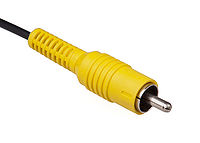Composite video
 | |
| Physical Connector: RCA connector, 1/8th inch jack, etc | |
|---|---|
| Video Signal: NTSC, PAL, or SECAM video |
Composite video is the format of an analog television (picture only) signal before it is combined with a sound signal and modulation|modulated onto an Radio Frequency|RF carrier wave|carrier. In contrast to component video (YPbPr) it contains all required video information, including colors in a single line-level signal. Like component video, composite-video cables do not carry audio and are often paired with audio cables (see RCA connector).
Composite video is often designated by the CVBS initialism, meaning "Color, Video, Blanking, and Sync."
It is usually in standard formats such as NTSC, PAL, and SECAM.
Demodulation loss
The process of modulating RF with the original video signal, and then demodulating the original signal again in the TV, introduces several losses. RF is also "noisy" because of all of the video and radio signals already being broadcast, so this conversion also typically adds noise or interference to the signal as well. For these reasons, it is typically best to use composite connections instead of RF connections if possible. Almost all modern video equipment has at least composite connectors, so this typically isn't a problem; however, older video equipment and some very low-end modern televisions have only RF input (essentially the antenna jack); while RF modulators are no longer common, they are still widely available to translate baseband signals for older equipment.
However, just as the modulation and demodulation of RF loses quality, the mixing of the various signals into the original composite signal does the same, causing a checkerboard video artifact known as dot crawl. Dot crawl is an infamous defect that results from crosstalk due to the intermodulation of the chrominance and luminance components of the signal. This is usually seen when chrominance is transmitted with a high bandwidth, and its spectrum reaches into the band of the luminance frequencies. This has led to a proliferation of systems such as S-Video and component video to maintain the signals separately. Comb filters are also commonly used to separate signals, and eliminate artifacts, from composite sources.